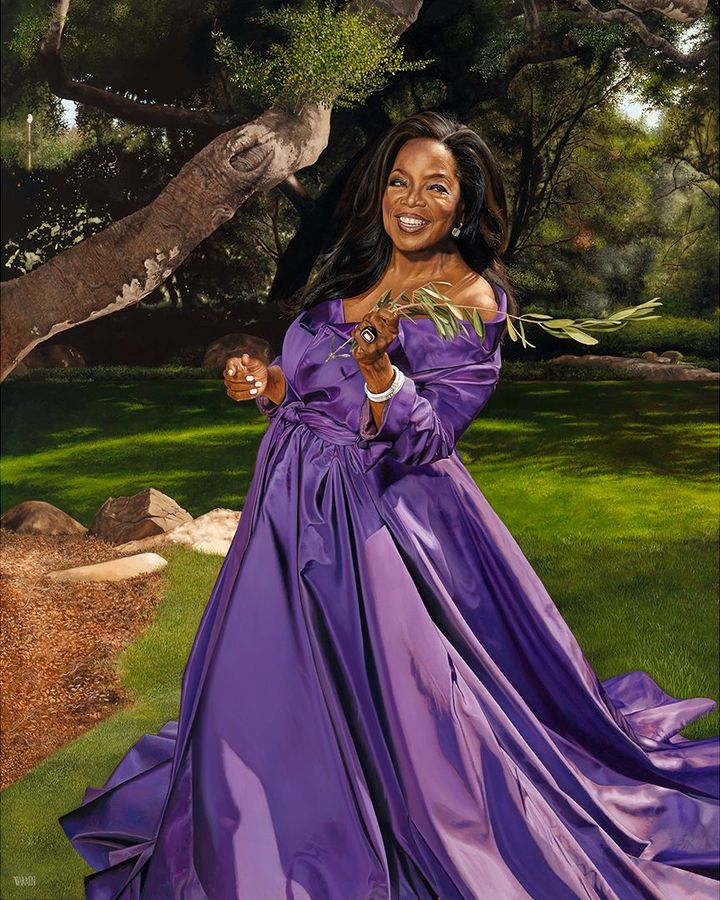What the purple dress in Oprah Winfrey's new portrait really means
A new portrait of Oprah Winfrey has just been unveiled in Washington DC. It draws on symbols used by the Old Masters, and hints at the unexpected origins of the colour purple.

Oprah Winfrey by Shawn Michael Warren (2023) (Credit: National Portrait Gallery, Smithsonian Institution)
That disconnect has defined the colour's aura for centuries, particularly as it relates to so-called Tyrian purple, an ancient dye that was once reserved for enrobing royalty. Distilled since antiquity from mucus secretions collected from sea snails, purple's odious origins were always at odds with the simple regality of its symbolism.
A cultural thread can be stretched from the flowing gowns of the floating angel in the Italian High Renaissance master Raphael's early oil-on-wood The Resurrection of Christ to the jaunty flounce of Oprah's own purple gown. Both depictions, old and new, manage to take a colour that is saturated in unpleasantness and privilege and recast it as something pure and new.
A symbol of peace and strength
It isn't only what Winfrey is wearing that intrigues. She is portrayed holding a long olive branch, an age-old symbol of peace that recurs in art history from Ancient Egyptian fresco fragments to Picasso's dove of peace. But here, the sprig does not appear to be one that Winfrey is intending to offer to another as a gesture of friendship, reconciliation, or unity. Far from it. She is left-handed and appears firmly to be clenching the stem with conspicuous strength in her dominant fist, as if she is about to pierce or puncture something with it – to make a point.
Here, the olive branch is not an indication of meek mindedness or the psyche of surrender, but seems to signal a circumspect ethos of "peace through strength", as cautious leaders like to say. A portrait of Queen Elizabeth I by the Flemish master Marcus Gheeraerts the Elder, painted between 1580 and 1585, springs to mind. There, the impassive Queen twiddles an olive branch in her fingers amiably enough while, at the same time, tapping her right toe on the sword of Justice (symbol of her supreme power) that lies at her feet. You know, just in case. Shuttle your eyes back and forth between the sharp end of the snapped stem Winfrey is holding and her winning grin, and one begins to sense a slightly steely edge to the momentary mirth – a cautious resolve.
Is there reason to assume Warren is astutely steeped in the history of art, its symbols and subtleties, or intent on transforming tradition? Earlier portraits by the artist, such as one of the fictional matriarch of the island of California, Queen Calafia (the creation of Spanish poet Garci Rodríguez de Montalvo – Warren's painting hangs in the US Embassy in Madrid), bristle with comparable intensity and allusions.
Warren knows his artistic forebears and isn't afraid to summon and spar with them in powerful paintings and murals that reveal his attentiveness to historical research. Untrained until he entered the American Academy of the Art as a college student, Warren cut his teeth scrutinising the work of Old Masters in Florence – an assiduousness that is evident in his colossal, almost sculptural portrait-mural of Martin Luther King, Jr. In the figure of Oprah Winfrey, who commands an impressively far-reaching respect in American life, Warren was charged with his most challenging subject yet – a living national treasure. Did he succeed? And then some.
If you liked this story, sign up for The Essential List newsletter – a handpicked selection of features, videos and can't-miss news delivered to your inbox every Friday.
If you would like to comment on this story or anything else you have seen on BBC Culture, head over to our Facebook page or message us on Twitter.





































